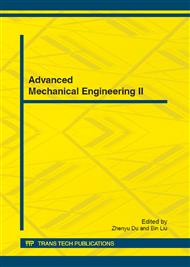[1]
Kuk-Hyun Han, Sinn Kim, Yong-Jae Kim, Jong-Hwan Kim. Internet Control Architecture for Internet-Based Personal Robot[J]. Autonomous Robots, (2001), 10(2).
DOI: 10.1109/robot.2001.932556
Google Scholar
[2]
SC Landry, KA McKean, CL Hubley-Kozey, WD Stanish, KJ Deluzio. Neuromuscular and lower limb biomechanical differences exist between male and female elite adolescent soccer players during an unanticipated run and crosscut maneuver . Am J Sports Med, (2007).
DOI: 10.1177/0363546507307400
Google Scholar
[3]
CD Pollard, SM Sigward, CM Powers. Gender differences in hip joint kinematics and kinetics during side-step cutting maneuver . Clin J Sport Med, (2007), 17 : 38-42.
DOI: 10.1097/jsm.0b013e3180305de8
Google Scholar
[4]
ML Beaulieu, M Lamontagne, L Xu. Gender differences in time-frequency EMG analysis of unanticipated cutting maneuvers . Med Sci Sports Exerc, (2008), 40 : 1795-1804.
DOI: 10.1249/mss.0b013e31817b8e9e
Google Scholar
[5]
AL Bell, DR Pedersen, RA Brand. A comparison of the accuracy of several hip center location prediction methods . J Biomech. (1990), 23 : 617-621.
DOI: 10.1016/0021-9290(90)90054-7
Google Scholar
[6]
N Cortes, J Onate, J Abrantes, L Gagen, E Dowling, B Lunen. Effects of gender and foot-landing techniques on lower extremity kinematics during drop-jump landings . J Appl Biomech, (2007), 23 : 289-299.
DOI: 10.1123/jab.23.4.289
Google Scholar
[7]
Faude, O, Junge, A, Kindermann, W, Dvorak,J. Injuries in female soccer players. A prospective study in the German national league . Am J Sports Med, (2005), 33 : 1694~1700.
DOI: 10.1177/0363546505275011
Google Scholar
[8]
Ford, KR, Myer, GD, Toms, HE. Gender differences in the kinematics of unanticipated cutting in young athletes . Med Sci Sports Exe January, (2005), 37 (1) : 124~129.
DOI: 10.1249/01.mss.0000150087.95953.c3
Google Scholar
[9]
Krosshaug T, Nakamae A, Boden B et al. Estimating3D joint kinematics from video sequences of running and cutting maneuvers—assessing the accuracy of simple visual inspection . Gait&Posture. (2007), 26 : 378-385.
DOI: 10.1016/j.gaitpost.2006.10.010
Google Scholar
[8]
Le Gall F, Carling C, Reilly T. Injuries in young elite female soccer players: an 8-season prospective study[J] . Am J Sports Med, (2008), 36 (2) : 276-284.
DOI: 10.1177/0363546507307866
Google Scholar
[9]
Lin CF, Gross M, Garrett WR, Yu B. A stochastic biomechanical model for risk and risk factors of non - contact anterior cruciate ligament injuries . J Biomech. (2009), 42 : 418-423.
DOI: 10.1016/j.jbiomech.2008.12.005
Google Scholar
[10]
Lohmander LS, Englund PM, Dahl LL, et al. The long-term consequence of an- terior cruciate ligament and meniscus injuries: osteoarthritis . Am J Sports Med, (2007), 35 (10) : 1756-1769.
DOI: 10.1177/0363546507307396
Google Scholar


